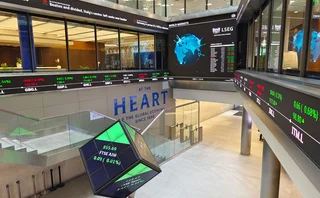
Hedge fund of the year: Citadel
Risk Awards 2023: “Intense” risk management produced returns that appear “almost impossible”

To understand what went on at hedge fund Citadel last year, a good place to start is in the firm’s fundamental equity division. The tempest in global stock markets, which to a large extent defined 2022 for investors, seemed somehow to pass Citadel’s portfolio managers by. “It’s as if they’re playing a different game,” says a long-time client of the hedge fund group.
In many ways, last year, they were.
Citadel’s equity portfolio managers made no big market calls. There were no killer trades predicated on timing the market, no top-down wagers on the likelihood of a Fed pivot or value beating growth. Their job instead was to neutralise all the market-wide risks the firm wished to avoid, leaving bets to stand on their individual merits.
The firm’s technology and “intense” risk management made that possible, says the client: “They’re just so dialled-in on exactly what it means when they are taking a position.”
We’re not taking beta. We’re not chasing factor themes. We’re looking for idiosyncratic winners and losers
Joanna Welsh, Citadel
Citadel’s equity PMs follow no house view, confirms Joanna Welsh, chief risk officer and head of the hedge fund’s Portfolio Construction and Risk Group (PCG) – the division responsible for watching over the firm’s wanted and unwanted risks.
“We’re not taking beta. We’re not chasing factor themes. We’re looking for idiosyncratic winners and losers.”
From January to December, while the S&P 500 lost a fifth of its value, Citadel’s equity fund climbed 21%, according to a source familiar with the firm’s performance.
The story was the same across the firm’s other investment strategies.
Citadel’s multi-strategy fund was up nearly 38%, Risk.net understands. All its five core strategies – equities, fixed income and macro, commodities, credit and quant – were profitable for the year. The firm’s global fixed-income fund is up more than 32%. Its Tactical Trading fund is up more than 26%.
Global bond markets experienced a once-in-a-decade slide in 2022. Volatility in rates climbed to levels unseen since the start of the Covid pandemic. Liquid markets ossified. Yet Citadel’s grip on its risk-taking allowed the firm to duck selloffs across markets and focus its bets in areas where the promise of returns was highest.
“Maybe that’s not the sexy secret sauce story,” Welsh says. “But it’s the sort of thing that’s easy to say and a lot more difficult to do – and to stick to.”
A second client describes Citadel as pushing up against the limits of investing’s efficient frontier: minimising the correlation between its portfolio managers and between strategies, and maximising return versus risk.
The firm’s flagship Wellington multi-strategy fund has delivered annualised net returns of more than 19% since its inception in 1990.
What Citadel is doing, the client says, appears “almost impossible”.
Mo’ metadata
Ken Griffin, Citadel’s chairman, hired Welsh in 2017 from Tudor Investment Corporation to bring a more forward-looking emphasis to the firm’s risk management. And Citadel began work around that time on the suite of tech that today keeps it current on its risks.
Floor-to-ceiling curved touchscreens in its Chicago office famously display the firm’s risks, stresses and liquidity.
Its risk systems have seen a series of seemingly mundane but meaningful upgrades. The firm started a project to enrich the market data it gathers, recording oil and gas prices in comparable common units as well as raw form, for example – tagging bonds as on- or off-the-run, and so on. Data, as it comes into the firm from vendors, lacks such detailed labelling, Welsh explains.
“There’s no system out there that if you’re trading, say, energy globally, can put everything into the metrics you'd want,” she says. “Having a really rich set of metadata associated with any instrument enables us to look at risk scenarios in lots of dimensions, seamlessly.”
Meanwhile, a “wholesale evolution” of Citadel’s trade processing has made it possible to render risks visible in real time. Digital information about each trade flows through a so-called message bus – middleware that manages the flow of communication between different applications across Citadel’s PCG, its portfolio managers and trade operations.
The risk team is able to “latch on” to packets of data for its analytics, says Welsh. “You can think of the businesses and trade operations as continuously broadcasting to each other and to the risk team.”
Today, for example in convertibles, Welsh’s team is able instantly to see how much risk in a position comes from credit spreads, or from the equity underlying or rates, and how much from funding.
Once bitten
The preoccupation with future-proofing the business goes back far – and comes from the top.
Griffin told Risk.net in a 2021 interview that managing risk was about what the firm does “before the event”.
“Once it starts it’s like a bolt of lightning,” he said.
Griffin should know. In 2008, the firm was rumoured to be close to collapse. Citadel lost 55% and was forced to gate its funds. The following year, though, the firm bounced back, delivering 62% net returns.
The recovery owed much to Griffin’s efforts to learn from earlier market shocks, including some that caused losses at Citadel itself: Black Monday in 1987, rate hikes in 1994 and the bailout of Long-Term Capital Management.
The value in dissecting risk, then, is something of a foundational principle. Welsh says several times during the interview that the attribution of risk numbers matters as much as the numbers themselves.
Shortening the odds
The firm’s team of more than 50 in the PCG keeps its proprietary risk factor model under constant review, comparing what the model said would drive risk with empirical data after the fact.
When events such as the relaxation of Covid lockdowns in China suggest an emerging structural driver in markets, Welsh’s team builds and tests new orthogonal “transient factors” and adds them to the model if they explain something new.
The firm’s devotion to stress-testing is near obsessional. The PCG is able – easily and quickly – to work up multiple variations on scenarios, mixing new combinations of stresses of different types.
As one example, the team “can see what might happen to supply and demand in commodities with a regular price shock, say, or with a price shock and a weather move, or with both and an infrastructure problem as well,” Welsh says.
The firm does this for more than just the most catastrophic scenarios. Citadel often trains its attention on the kinds of smaller business-specific risks that occur more frequently.
Doing so improves the odds of achieving positive results. “Effectively, you get more ‘at-bats’,” says Welsh, referring to a player’s turn in baseball. “You start to learn where you have good predictability and less good predictability.”
Welsh’s team has the capacity to run any of these stress tests at the fund level, for an individual business unit or for a portfolio.
Inside the box
Responsibility for ridding portfolios of unwanted exposures rests with portfolio managers. “They have to own the risk,” Welsh says. “Always.”
Here, discipline is intense. “When they bring a new portfolio manager in,” the second client says, “borders are put in place and codified such that it’s basically impossible for that PM to take the funds down. The parameters are very strictly defined.”
The firm’s portfolio committee of senior executives, which Welsh chairs, assigns an annual “volatility allocation” to each individual manager, determining the risk the individual can take – even down to the level of individual factors.
Centrally propagated guidelines stipulate each portfolio’s required performance in stress tests. PMs must operate within concentration risk limits, funding risk stress guidelines and requirements on cross-asset sensitivities and liquidity.
Ken often talks about pushing decisions to the most junior person who is capable of making them, who is also often the closest to the relevant information
Joanna Welsh, Citadel
Welsh gives a sense of what this means in practice: “We don’t believe that equity portfolio managers should take beta risk, so equity portfolios have to be beta neutral.” The firm thinks that to generate alpha from the long side and the short side a portfolio must maintain a minimum level of idiosyncratic variance. PMs cannot hold more than a certain percentage in exchange-traded funds.
The approach might seem draconian. But the aim is to put risk-taking in the hands of those best qualified to take it. “We don’t want a credit portfolio manager showing a large amount of macro stress, because those books are not meant to be macro directional. We want that risk to be taken by macro traders,” Welsh says.
Within the boundaries, the firm wants its portfolio managers to exercise initiative. “Ken often talks about pushing decisions to the most junior person who is capable of making them, who is also often the closest to the relevant information.”
The guardrails vary by asset class. In several of the businesses, a portfolio manager’s stress-scenario-to-volatility multiplier cannot exceed a threshold, for example. Citadel will trade only stocks that meet a minimum level of average daily turnover. “We don’t want people wasting their time on small ideas that don’t move the needle,” Welsh says.
Model behaviour
The winning hedge fund trade of 2022, of course, was to go long energy. Did Citadel step up its activities in commodities?
Welsh is non-committal. Citadel is able to size allocations “appropriately” and to “leverage its full AUM” if presented with an “extraordinary opportunity in the market,” she says, adding that multi-strategy firms that trade in silos might struggle to make that kind of switch of risk-taking from one area to another.
“I’m not going to divulge the extent to which we chose to allocate more or less, but I will tell you that these things are always and without exception done with conditions attached,” Welsh says.
She goes on to describe drawdown limits and the designation of “fundamental checking points” such as levels of gas storage, say, or decisions from oil-exporting countries that would need to be met for opportunistic trades to continue.
“Whenever portfolio managers are presented with exceptional opportunities to deploy risk beyond their individual frameworks, Ken and other senior leaders will review all the research,” Welsh says. “Is the trade fundamentally sound? Is the consideration of downside well thought out? Does it deserve additional capacity up to a level that we can comfortably accommodate?”
Elsewhere, the firm’s experience bears out the maxim that fortune favours the prepared mind.
Before Russia invaded Ukraine in February, Citadel’s commodities team had already weighed the implications of a delay to the Nord Stream 2 gas pipeline – work the firm could repurpose when a conflict started to look likely.
Granular tracking data on commodities supply and demand helped shape the firm’s thinking on the implications of war in other corners of the market. This proved “instrumental” in helping model inflation in Europe, the UK and the US, Welsh says.
Last year, Citadel also rolled out new country-specific stress tests for basis trading.
Ordinary stress tests look at times in which futures have richened, such as during Covid or the collapse of LTCM or Lehman. The risks in fixed-income relative value trading, though, are poorly described by such scenarios, Welsh argues. “It’s a very idiosyncratic business. You need a bespoke approach.”
When futures richen, the bonds that form the other leg of a basis trade may or may not richen too. “You might be shocking your futures and all of your bond positions in the same way, and you’ll miss the risk factor.”
Citadel itself was reportedly among several hedge funds that suffered temporary markdowns in 2020 when cash bond prices collapsed against futures, before a Federal Reserve intervention brought prices back in line.
Now, the firm is taking no chances. Welsh’s team collated a set of curve data that allowed the firm to model the basis as a risk factor – and track the factor’s behaviour for futures against bonds and on-the-run against off-the-run bonds, across multiple countries.
The effort to insulate the business from unpredictable market forces is not letting up.
Citadel is building a second version of its risk display wall at the firm’s new offices on 425 Park Avenue in New York — a 35-foot by 8-foot single screen on which executives can drill into performance, risk analytics or stress-test results and visualise what’s happening in Citadel’s funds as a “single narrative”.
Is Welsh confident her team has all the angles covered?
“Because we have built decades of data in the areas we trade, we know where we can and can’t predict risk and generally know where we should lean in or lean out,” she says. “But you have to always have a lot of respect for risk. The world is unpredictable, and hubris can do a lot of damage. Part of our culture is to take nothing for granted.”
Only users who have a paid subscription or are part of a corporate subscription are able to print or copy content.
To access these options, along with all other subscription benefits, please contact info@risk.net or view our subscription options here: http://subscriptions.risk.net/subscribe
You are currently unable to print this content. Please contact info@risk.net to find out more.
You are currently unable to copy this content. Please contact info@risk.net to find out more.
Copyright Infopro Digital Limited. All rights reserved.
As outlined in our terms and conditions, https://www.infopro-digital.com/terms-and-conditions/subscriptions/ (point 2.4), printing is limited to a single copy.
If you would like to purchase additional rights please email info@risk.net
Copyright Infopro Digital Limited. All rights reserved.
You may share this content using our article tools. As outlined in our terms and conditions, https://www.infopro-digital.com/terms-and-conditions/subscriptions/ (clause 2.4), an Authorised User may only make one copy of the materials for their own personal use. You must also comply with the restrictions in clause 2.5.
If you would like to purchase additional rights please email info@risk.net
More on Awards
Clearing house of the year: LCH
Risk Awards 2025: LCH outshines rivals in its commitment to innovation and co-operation with clearing members
Best use of machine learning/AI: CompatibL
CompatibL’s groundbreaking use of LLMs for automated trade entry earned the Best use of machine learning/AI award at the 2025 Risk Markets Technology Awards, redefining speed and reliability in what-if analytics
Markets Technology Awards 2025 winners’ review
Vendors jockeying for position in this year’s MTAs, as banks and regulators take aim at counterparty blind spots
Equity derivatives house of the year: Bank of America
Risk Awards 2025: Bank gains plaudits – and profits – with enhanced product range, including new variants of short-vol structures and equity dispersion
Law firm of the year: Linklaters
Risk Awards 2025: Law firm’s work helped buttress markets for credit derivatives, clearing and digital assets
Derivatives house of the year: UBS
Risk Awards 2025: Mega-merger expected to add $1 billion to markets revenues, via 30 integration projects
Interest rate derivatives house of the year: JP Morgan
Risk Awards 2025: Steepener hedges and Spire novations helped clients navigate shifting rates regime
Currency derivatives house of the year: UBS
Risk Awards 2025: Access to wealth management client base helped Swiss bank to recycle volatility and provide accurate pricing for a range of FX structures







